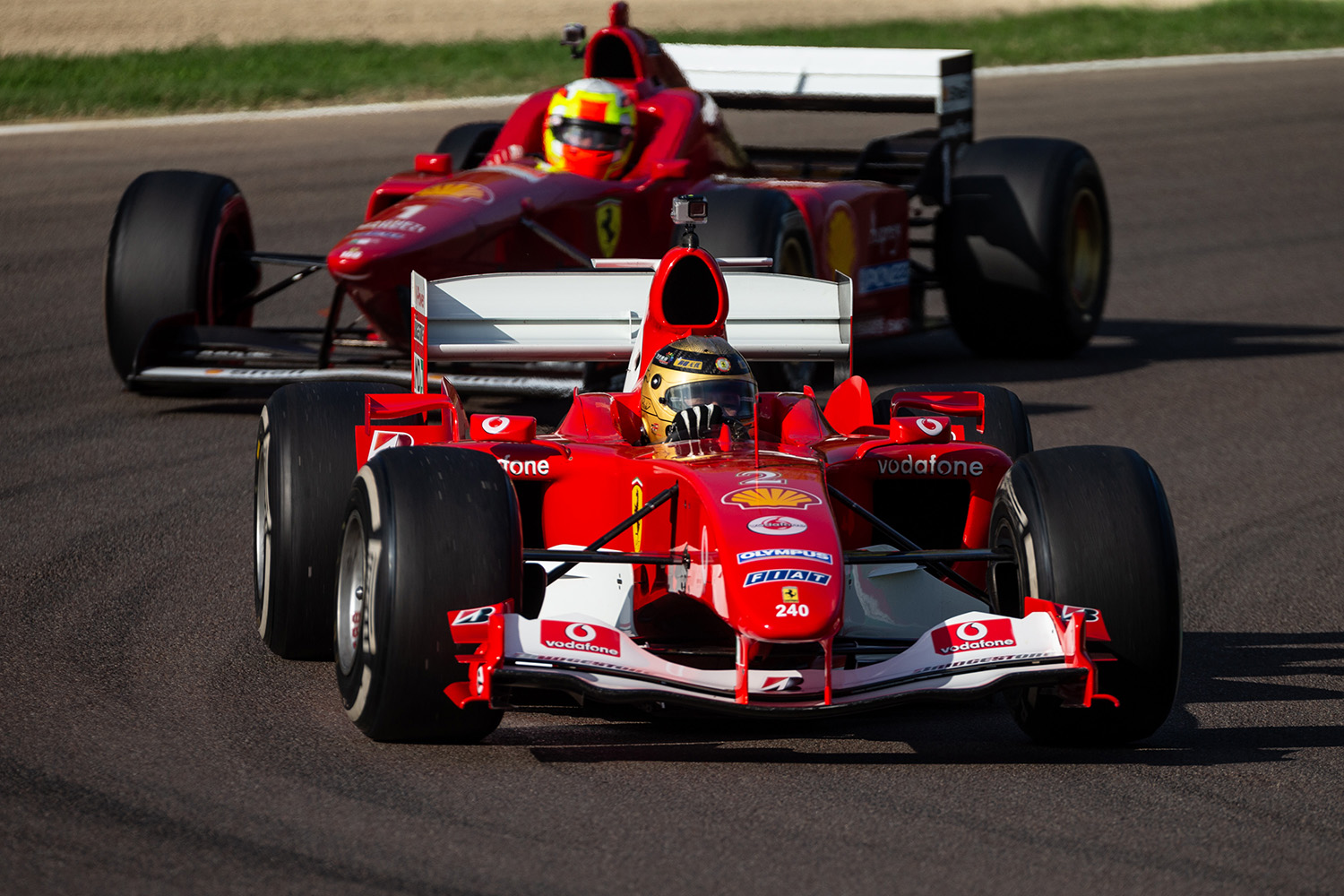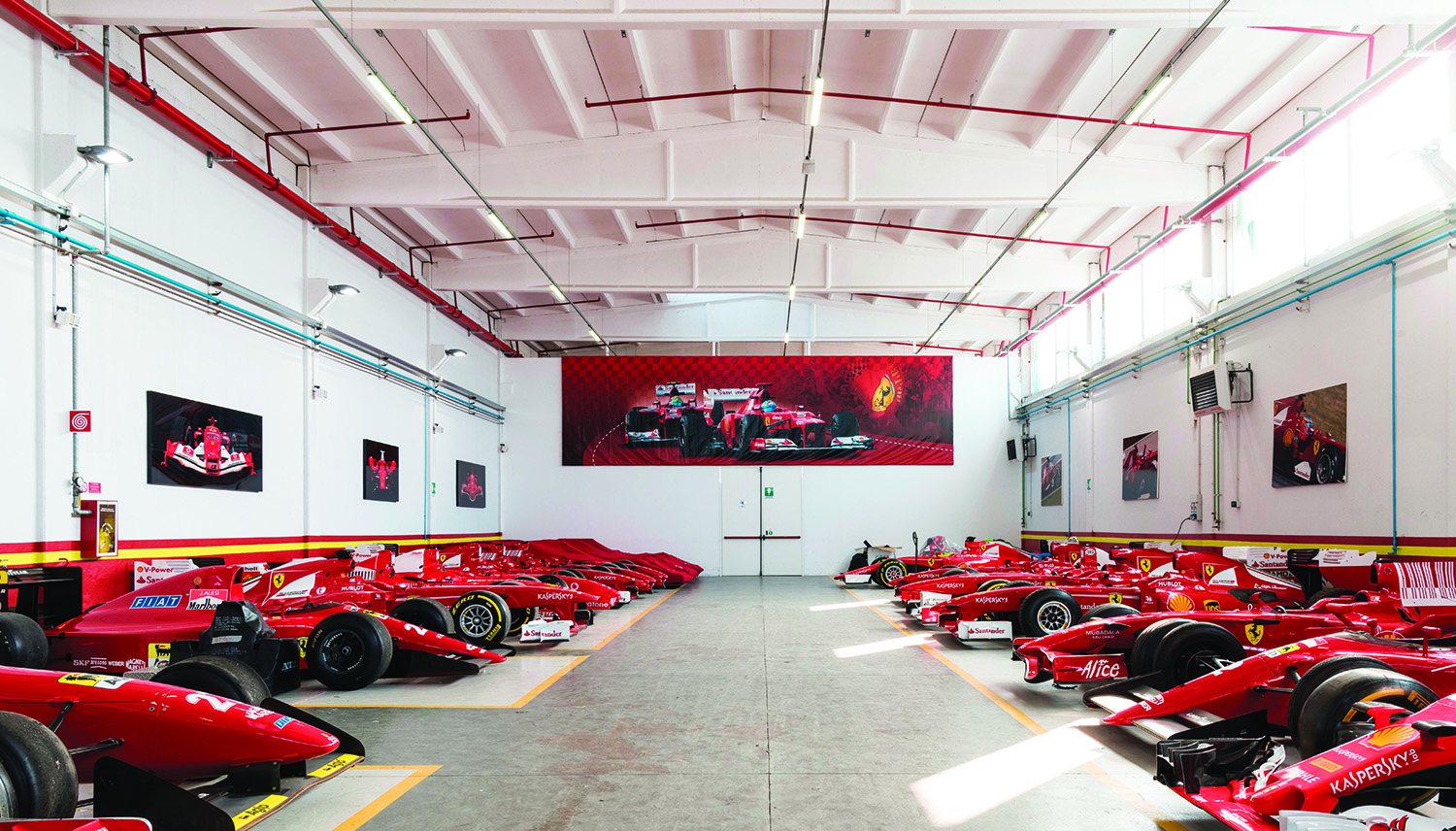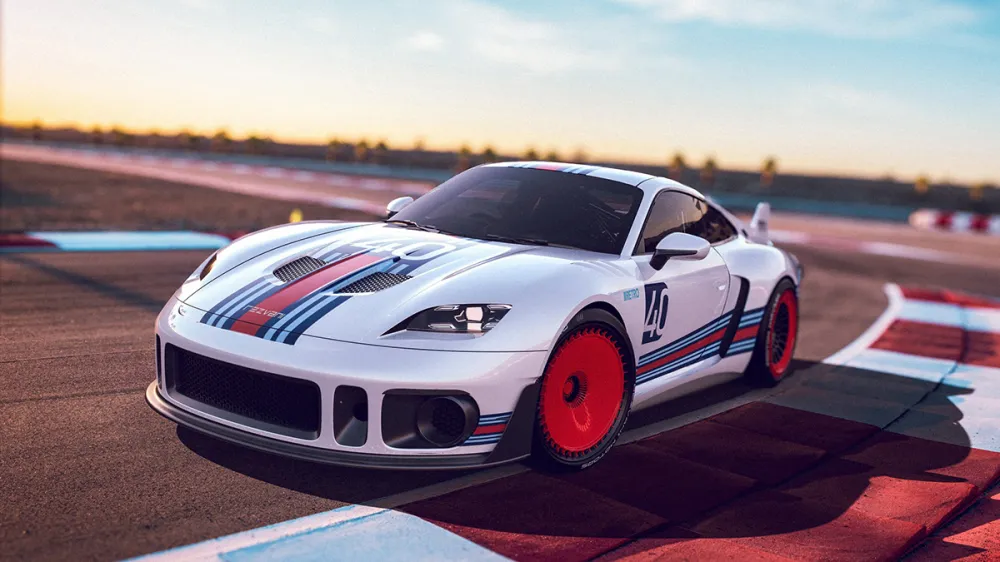
Pole Position: Welcome To The Ultra-Exclusive World of F1 Corse Clienti
Fancy pegging Schumacher’s former Ferrari about the track? Here’s How
Related articles
You’ve done well in life. The garage has swollen to several excitable cars with silly doors and even sillier exhausts. And then the garage becomes an offsite warehouse while you talk to the council about the very real need for a below ground, backyard lair to house your many exotic wonders. But where to go next from this already gilded point of auto ownership?
Might we suggest trying something from Ferrari? Specifically a former Formula One car. Preferably one of the properly loud, older ones. Perhaps even one of those in which Michael Schumacher won a race or two… Yes, through the F1 Corse Clienti program, one of these dream machines could be yours.
This might seem fantastical, and damn fantastic, but also know it to be something that those generous folk at the famed Italian marque only offer to a select group of most-trusted (read: wealthy) customers.
And, amusingly, don’t expect to take part in F1 Corse Clienti if you look like Clive Palmer or James Packer – because if you’re not small enough to fit into an F1 car, you’re not allowed to buy one.
“These cars were made to be driven, and we insist that they are,” states Antonello Coletta, head of Ferrari’s Sporting Activity Department.
That’s right, as insane as it seems, Ferrari won’t let you purchase its treasured, history-making cars and park them in a living room (in fact, they don’t really like you taking them home, preferring to store them at Maranello before flying them out when you want to drive them). And you have to be willing to attempt to master them.
As imagined, particularly in the case of some of the more mental V10-versions from the deafening days of yore, this is quite the challenge. And it’s no good trying to tool around a track slowly just so you can feel like a hero.
“You need to go fast enough to get heat into the tyres, and, to get the downforce, you have to have enough speed to trigger the aero or you’re just going to spin off straight away,” Coletta adds, grinning like the man-boy 51 year old he is.
“The first hurdle is the customer must fit in the car, that’s the first problem. When we resolve this, then everyone wants to drive it, if the fit is okay. We are lucky, because we have a lot of sporty clients, so it’s quite easy to find people to take part in such an activity.”
The program features several track days held around the world throughout the year – from the Nurburgring to Suzuka, Imola, Bahrain and beyond. F1 Cliente has been running since 2003, with “60 or 70 drivers and owners”, of which roughly
a dozen turn up to each event, happy to fork out an easy million (and more) for the opportunity annually.
To take part, of course, they also have to first prove they’re good enough.
“Honestly, it’s impossible that any driver could take a car like this on to a track and do an event without a lot of experience – it’s simply impossible, they would not be physically able,” Coletta insists.
“So first we organise a test [at Ferrari’s private circuit] Fiorano, when we deliver the car, with our drivers, like [F1 test driver] Marc Gené, and we look at the situation. Marc will tell you the average level is very good and the hardest thing is putting the car in first gear, and getting it out of the pits. With older cars this was even more difficult, with the hand clutch.”
There’s also the small matter of being able to use an F1 car’s complex steering wheel. Colette says this, on its own, takes half a day of training.

“The first time driving, for any customer, it’s very noisy, but honestly, after four or five sessions around Fiorano, it’s possible to enter in our events and drive with maximum safety,” says Coletta.
Spins and crashes are apparently – and perhaps surprisingly – minimal.
“We see a lot of joy from people, a lot of happy people. This is a game, an expensive game, but it’s a game. It’s not about racing, it’s about experiencing these amazing cars.
“Customers who drive the F1 – it’s the maximum for them, it’s the best dream, to drive a Ferrari F1. To own a car like this, and to drive it, and why not to have the chassis that Schumacher won two or three races with? Or Massa or Raikkonen?”
Some of those cars, those chassis, are even signed by their former pilots.
“It’s a piece of motoring history, but we let people drive it,” says Coletta.
By this stage in our Italian tour we’ve reached the inner-sanctum of Maranello, where the F1 cars are stored. Coletta is waving his arms theatrically, gesturing to the wondrous collection of racing masterpieces that date back to the 1980s.
Our jaw is on the floor given we’re able to glimpse more than 50 heroic cars of days gone by, in various gleaming red hues. We’re also able to examine the strange development of the F1 seating position, which is now akin to lying in a bath and using your feet on the taps to drive.
The big question, of course, is just how hard are these lucky punters driving these things? If Schumacher drove an F1 car
at ten-tenths, at what level is a customer – four tenths? Five?
Coletta looks as if we’ve just suggested drinking coffee is about to be made illegal and delivers a noise of obvious dissent.
“No, no, no. Schumacher’s teammates drove at five-tenths compared to him. For the customers it’s much lower, maybe like two or three tenths,” he shrugs.
Firing up a Ferrari for a track day requires a team of engineers and their laptops, the original Pirelli rubber and some very expensive spare parts. Unfortunately, that’s the cheap and easy version, compared to modern F1 cars. As Coletta explains, the Clienti program has been forced to cut the sale of cars from the 2013 season onwards.
“The new generation cars are too complex,” he says. “With the old ones you can get them running with four or six engineers – but you need 24 or 25 people just to run a car from 2014 and beyond.

“It’s also very dangerous, because if you don’t manage it, someone can be electrocuted, because of the KERS
[kinetic energy recovery system]. But we are working for the future to some kind of solution for these new generations.”
Coletta adds: “We are uncomfortable to have the Ferraris not running, so we will have to find another way. Selling it to someone just to have it standing there is not our philosophy.”
It should come as no surprise that Coletta, a Ferrari employee of 21 years and a fan for even longer, nominates the older F1 cars as his favourites (and he hints that he’s pretty much driven them all).
“The older car was better than the car of today – just look at the clean lines, the passion, the appeal… For me they were completely different, honestly,” he says.
“I love all the cars of the past, they were a more human car, no need to sit with your feet higher than your nose.
“And with the older rules it was easier to make a lot of chassis. Today there are very limited number of chassis, only six or seven a year. In the past it was nothing to have 10 or more, and then we had more engines, too; an engine for the qualifying, an engine for the race. We have a separate storage area with an amazing number of engines. It’s just fantastic.”
Fantastic is indeed the word for the heady world of the F1 Corse Clienti program. Fantastic – if you can afford it.
This piece comes from our 2019 Summer Edition – to get your copy click here.
Subscribe to the Newsletter
Recommended for you
8 Fascinating Facts You Didn’t Know About Aston Martin
The British sports car company is most famous as the vehicle of choice for James Bond, but Aston Martin has an interesting history beyond 007.
May 1, 2024
Rezvani Will Rebuild Your 911 to Go From Zero to 100 in Two Seconds
The shop will build a version of the RR1 based on the Carrera S, GT3, and Turbo S
By Bryan Hood
April 23, 2024
You may also like.
You may also like.
Watch of the Week: TAG Heuer Formula 1 | Kith
At last, the original Formula 1 returns, but with an unexpected twist.
Over the last few years, watch pundits have predicted the return of the colourful and eccentric TAG Heuer Formula 1, in some shape or form. You could say that the writing was on the wall when TAG Heuer’s heritage director, Nicholas Biebuyck, teased a plethora of vintage models across his Instagram account in the aftermath of Watches & Wonders 2023. In fact, speaking with Frédéric Arnault at last year’s trade fair in Geneva, the former CEO asked me directly if the brand were to relaunch its legacy Formula 1 collection, loved by collectors globally, how should they do it?
My answer to the baited question, whilst informed (in my opinion), definitely didn’t mention a collaboration with Ronnie Fieg of Kith, one of the world’s biggest streetwear fashion labels, but here were are: the TAG Heuer Formula 1 is officially back and as colourful as ever.
As the watch industry truly enters its hype era—in recent years, we’ve seen MoonSwatches, we’ve seen Scuba Fifty Fathoms, we’ve seen John Mayer G-Shocks—the new Formula 1 x Kith collaboration might just be the coolest yet.
Here’s the lowdown: overnight, TAG Heuer, together with Kith, took to socials to unveil a special, limited edition collection of Formula 1 timepieces, inspired by the original collection from the 1980s. There’s 10 new watches in total, all limited, with some designed on a stainless steel bracelet, and some on an upgraded rubber strap; both options a direct nod to the originals.
Seven are exclusive specifically to Kith and its global stores; New York, Los Angeles, Miami, Hawaii, Tokyo, Toronto, and Paris, to be specific, and are made in an abundance of colours, like the originals. Two are then exclusive to TAG Heuer; and one is “shared” between TAG Heuer and Kith – this is a highlight of the collection, in our opinion. A faithful play on the original watch from 1986, this model, limited to just 1350 pieces globally, features the classic black bezel with red accents and a creamy-taupe, vintage-inspired dial. This particular model arrives on a steel bracelet with an eggshell dial, and will present as pure nostalgia for those old enough to remember when the original TAG Heuer Formula 1 made its debut.

Of course, across the entirety of the collection, you will find Fieg’s design cues punctuated throughout: the “TAG” is replaced with “Kith”, forming a contentious new brand name for this specific release, as well as Kith’s slogan “Just Us”.
Collectors and purists alike will appreciate the dedication to the original Formula 1 collection: features like 35mm sizing—close enough to its original 34mm size—the form hour hand, a triangle with a dot inside at 12 o’clock, indices that alternate every quarter between shields and dots, and a contrasting minuterie, are all welcomed design specs that make this collaboration so great.
Every TAG Heuer Formula 1 | Kith timepiece will be presented in an eye-catching box that compliments the fun and colour-theme of the Formula 1, but all the same drives home the premium status of this collaboration. On that note, at $2,200 a piece, this isn’t exactly an approachable quartz watch, but rather reflects the exclusive nature of Fieg’s Kith brand and the pieces he designs (largely, limited-edition).

So, what do we really think? It’s important not to understate the significance of the arrival of the TAG Heuer Formula 1 in 1986, in what would prove integral in setting up the brand for success throughout the 90’s—it was the very first watch collection to have “TAG Heuer” branding, after all—but also in helping to establish a new generation of watch consumer; many enthusiasts will recall on the Formula 1 as their very first watch.
This is as faithful of a reissue as we’ll get from TAG Heuer right now, and buddying watch fans should be pleased with the result. The collection has been executed extraordinarily well, pondered on for years, and to TAG Heuer’s credit, a great deal of research has gone into perfecting and replicating the proportions, materials and aesthetic of this iconic collection for the modern day consumer. Sure, it would have been nice to see a full lume dial, a distinguishing feature of the original—why this wasn’t done is lost on me—and perhaps a more approachable price point, but there’s no doubt these will become an instant hit in the days to come.
—
The TAG Heuer Formula 1 | Kith collection will be available on Friday, May 3rd, exclusively in-store at select TAG Heuer and Kith locations in Miami, and available starting Monday, May 6th, at select TAG Heuer boutiques, all Kith shops, and online at Kith.com. To see the full collection, visit tagheuer.com
You may also like.
8 Fascinating Facts You Didn’t Know About Aston Martin
The British sports car company is most famous as the vehicle of choice for James Bond, but Aston Martin has an interesting history beyond 007.
Aston Martin will forever be associated with James Bond, ever since everyone’s favourite spy took delivery of his signature silver DB5 in the 1964 film Goldfinger. But there’s a lot more to the history of this famed British sports car brand beyond its association with the fictional British Secret Service agent.
Let’s dive into the long and colourful history of Aston Martin.
You may also like.
What Venice’s New Tourist Tax Means for Your Next Trip
The Italian city will now charge visitors an entry fee during peak season.
Visiting the Floating City just got a bit more expensive.
Venice is officially the first metropolis in the world to start implementing a day-trip fee in an effort to help the Italian hot spot combat overtourism during peak season, The Associated Press reported. The new program, which went into effect, requires travellers to cough up roughly €5 (about $AUD8.50) per person before they can explore the city’s canals and historic sites. Back in January, Venice also announced that starting in June, it would cap the size of tourist groups to 25 people and prohibit loudspeakers in the city centre and the islands of Murano, Burano, and Torcello.
“We need to find a new balance between the tourists and residents,’ Simone Venturini, the city’s top tourism official, told AP News. “We need to safeguard the spaces of the residents, of course, and we need to discourage the arrival of day-trippers on some particular days.”
During this trial phase, the fee only applies to the 29 days deemed the busiest—between April 25 and July 14—and tickets will remain valid from 8:30 am to 4 pm. Visitors under 14 years of age will be allowed in free of charge in addition to guests with hotel reservations. However, the latter must apply online beforehand to request an exemption. Day-trippers can also pre-pay for tickets online via the city’s official tourism site or snap them up in person at the Santa Lucia train station.
“With courage and great humility, we are introducing this system because we want to give a future to Venice and leave this heritage of humanity to future generations,” Venice Mayor Luigi Brugnaro said in a statement on X (formerly known as Twitter) regarding the city’s much-talked-about entry fee.
Despite the mayor’s backing, it’s apparent that residents weren’t totally pleased with the program. The regulation led to protests and riots outside of the train station, The Independent reported. “We are against this measure because it will do nothing to stop overtourism,” resident Cristina Romieri told the outlet. “Moreover, it is such a complex regulation with so many exceptions that it will also be difficult to enforce it.”
While Venice is the first city to carry out the new day-tripper fee, several other European locales have introduced or raised tourist taxes to fend off large crowds and boost the local economy. Most recently, Barcelona increased its city-wide tourist tax. Similarly, you’ll have to pay an extra “climate crisis resilience” tax if you plan on visiting Greece that will fund the country’s disaster recovery projects.
You may also like.
Omega Reveals a New Speedmaster Ahead of the Paris 2024 Olympics
Your first look at the new Speedmaster Chronoscope, designed in the colour theme of the Paris Olympics.
The starters are on the blocks, and with less than 100 days to go until the Paris 2024 Olympics, luxury Swiss watchmaker Omega was bound to release something spectacular to mark its bragging rights as the official timekeeper for the Summer Games. Enter the new 43mm Speedmaster Chronoscope, available in new colourways—gold, black, and white—in line with the colour theme of the Olympic Games in Paris this July.
So, what do we get in this nicely-wrapped, Olympics-inspired package? Technically, there are four new podium-worthy iterations of the iconic Speedmaster.

The new versions present handsomely in stainless steel or 18K Moonshine Gold—the brand’s proprietary yellow gold known for its enduring shine. The steel version has an anodised aluminium bezel and a stainless steel bracelet or vintage-inspired perforated leather strap. The Moonshine Gold iteration boasts a ceramic bezel; it will most likely appease Speedy collectors, particularly those with an affinity for Omega’s long-standing role as stewards of the Olympic Games.
Notably, each watch bears an attractive white opaline dial; the background to three dark grey timing scales in a 1940s “snail” design. Of course, this Speedmaster Chronoscope is special in its own right. For the most part, the overall look of the Speedmaster has remained true to its 1957 origins. This Speedmaster, however, adopts Omega’s Chronoscope design from 2021, including the storied tachymeter scale, along with a telemeter, and pulsometer scale—essentially, three different measurements on the wrist.
While the technical nature of this timepiece won’t interest some, others will revel in its theatrics. Turn over each timepiece, and instead of a transparent crystal caseback, there is a stamped medallion featuring a mirror-polished Paris 2024 logo, along with “Paris 2024” and the Olympic Rings—a subtle nod to this year’s games.
Powering this Olympiad offering—and ensuring the greatest level of accuracy—is the Co-Axial Master Chronometer Calibre 9908 and 9909, certified by METAS.

A Speedmaster to commemorate the Olympic Games was as sure a bet as Mondo Deplantis winning gold in the men’s pole vault—especially after Omega revealed its Olympic-edition Seamaster Diver 300m “Paris 2024” last year—but they delivered a great addition to the legacy collection, without gimmickry.
However, the all-gold Speedmaster is 85K at the top end of the scale, which is a lot of money for a watch of this stature. By comparison, the immaculate Speedmaster Moonshine gold with a sun-brushed green PVD “step” dial is 15K cheaper, albeit without the Chronoscope complications.
—
The Omega Speedmaster Chronoscope in stainless steel with a leather strap is priced at $15,725; stainless steel with steel bracelet at $16,275; 18k Moonshine Gold on leather strap $54,325; and 18k Moonshine Gold with matching gold bracelet $85,350, available at Omega boutiques now.
Discover the collection here
You may also like.
Here’s What Goes Into Making Jay-Z’s $1,800 Champagne
We put Armand de Brignac Blanc de Noirs Assemblage No. 4 under the microsope.
In our quest to locate the most exclusive and exciting wines for our readers, we usually ask the question, “How many bottles of this were made?” Often, we get a general response based on an annual average, although many Champagne houses simply respond, “We do not wish to communicate our quantities.” As far as we’re concerned, that’s pretty much like pleading the Fifth on the witness stand; yes, you’re not incriminating yourself, but anyone paying attention knows you’re probably guilty of something. In the case of some Champagne houses, that something is making a whole lot of bottles—millions of them—while creating an illusion of rarity.
We received the exact opposite reply regarding Armand de Brignac Blanc de Noirs Assemblage No. 4. Yasmin Allen, the company’s president and CEO, told us only 7,328 bottles would be released of this Pinot Noir offering. It’s good to know that with a sticker price of around $1,800, it’s highly limited, but it still makes one wonder what’s so exceptional about it.
Known by its nickname, Ace of Spades, for its distinctive and decorative metallic packaging, Armand de Brignac is owned by Louis Vuitton Moët Hennessy and Jay-Z and is produced by Champagne Cattier. Each bottle of Assemblage No. 4 is numbered; a small plate on the back reads “Assemblage Four, [X,XXX]/7,328, Disgorged: 20 April, 2023.” Prior to disgorgement, it spent seven years in the bottle on lees after primary fermentation mostly in stainless steel with a small amount in concrete. That’s the longest of the house’s Champagnes spent on the lees, but Allen says the winemaking team tasted along the way and would have disgorged earlier than planned if they’d felt the time was right.
Chef de cave, Alexandre Cattier, says the wine is sourced from some of the best Premier and Grand Cru Pinot Noir–producing villages in the Champagne region, including Chigny-les-Roses, Verzenay, Rilly-la-Montagne, Verzy, Ludes, Mailly-Champagne, and Ville-sur-Arce in the Aube département. This is considered a multi-vintage expression, using wine from a consecutive trio of vintages—2013, 2014, and 2015—to create an “intense and rich” blend. Seventy percent of the offering is from 2015 (hailed as one of the finest vintages in recent memory), with 15 percent each from the other two years.

This precisely crafted Champagne uses only the tête de cuvée juice, a highly selective extraction process. As Allen points out, “the winemakers solely take the first and freshest portion of the gentle cuvée grape press,” which assures that the finished wine will be the highest quality. Armand de Brignac used grapes from various sites and three different vintages so the final product would reflect the house signature style. This is the fourth release in a series that began with Assemblage No. 1. “Testing different levels of intensity of aromas with the balance of red and dark fruits has been a guiding principle between the Blanc de Noirs that followed,” Allen explains.
The CEO recommends allowing the Assemblage No. 4 to linger in your glass for a while, telling us, “Your palette will go on a journey, evolving from one incredible aroma to the next as the wine warms in your glass where it will open up to an extraordinary length.” We found it to have a gorgeous bouquet of raspberry and Mission fig with hints of river rock; as it opened, notes of toasted almond and just-baked brioche became noticeable. With striking acidity and a vein of minerality, it has luscious nectarine, passion fruit, candied orange peel, and red plum flavors with touches of beeswax and a whiff of baking spices on the enduring finish. We enjoyed our bottle with a roast chicken rubbed with butter and herbes de Provence and savored the final, extremely rare sip with a bit of Stilton. Unfortunately, the pairing possibilities are not infinite with this release; there are only 7,327 more ways to enjoy yours.


























